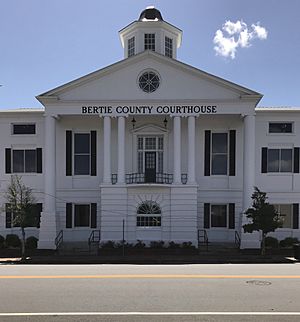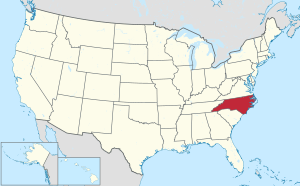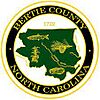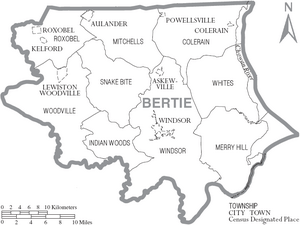Bertie County, North Carolina facts for kids
Quick facts for kids
Bertie County
|
|||
|---|---|---|---|

Bertie County Courthouse in Windsor
|
|||
|
|||

Location within the U.S. state of North Carolina
|
|||
 North Carolina's location within the U.S. |
|||
| Country | |||
| State | |||
| Founded | 1739 | ||
| Named for | James Bertie and/or Henry Bertie | ||
| Seat | Windsor | ||
| Largest community | Windsor | ||
| Area | |||
| • Total | 741.31 sq mi (1,920.0 km2) | ||
| • Land | 699.18 sq mi (1,810.9 km2) | ||
| • Water | 42.13 sq mi (109.1 km2) 5.61% | ||
| Population
(2020)
|
|||
| • Total | 17,934 | ||
| • Estimate
(2023)
|
16,922 | ||
| • Density | 25.65/sq mi (9.90/km2) | ||
| Time zone | UTC−5 (Eastern) | ||
| • Summer (DST) | UTC−4 (EDT) | ||
| Congressional district | 1st | ||
Bertie County (/ˌbɜːrˈtiː/ BUR-tee) is a county located in the northeast area of the U.S. state of North Carolina. As of the 2020 census, the population was 17,934. Its county seat is Windsor. The county was created in 1722 as Bertie Precinct and gained county status in 1739.
Contents
History
The county was formed as Bertie Precinct in 1722 from the part of Chowan Precinct of Albemarle County lying west of the Chowan River. It was named for James Bertie, his brother Henry Bertie, or perhaps both, each having been one of the Lords Proprietors of Carolina.
In 1729 parts of Bertie Precinct, Chowan Precinct, Currituck Precinct, and Pasquotank Precinct of Albemarle County were combined to form Tyrrell Precinct. With the abolition of Albemarle County in 1739, all of its constituent precincts became separate counties. As population of settlers increased, in 1741 parts of Bertie County were organized as Edgecombe County and Northampton County. Finally, in 1759 parts of Bertie, Chowan, and Northampton counties were combined to form Hertford County. Bertie's boundaries have remained the same since then.
This mostly rural county depended on the agricultural economy well into the 20th century. In the colonial and antebellum eras, tobacco and cotton were the chief commodity crops, worked by Indian and African slaves. After the Civil War, agriculture continued to be important to the county. In the 21st century, developers have referred to it as being within the Inner Banks region, which is increasingly attracting retirees and buyers of second homes, because of its beaches and landscapes.
Geography
According to the U.S. Census Bureau, the county has a total area of 741.31 square miles (1,920.0 km2), of which 699.18 square miles (1,810.9 km2) is land and 42.13 square miles (109.1 km2) (5.61%) is water.
National protected area
State and local protected areas/sites
- Bachelor Bay Game Land (part)
- Bertie County Game Land
- Chowan Swamp Game Land (part)
- Historic Hope Plantation
- Jamesville Wildlife Preserve
- Lewiston Woodville Preserve
- Lower Roanoke River Wetlands Game Land (part)
- Salmon Creek State Natural Area
- Upper Roanoke River Wetlands Game Land (part)
Major water bodies
- Albemarle Sound
- Beaverdam Swamp
- Cashie River
- Chowan River
- Chinkapin Swamp
- Cucklemaker Creek
- Cypress Swamp
- Falt Swamp Creek
- Hoggard Mill Creek
- Loosing Swamp
- Middle River
- Quioccosin Creek
- Roanoke River
- Stoney Creek
- Wahton Swamp
- Wildcat Swamp
Adjacent counties
- Hertford County – north
- Chowan County – east
- Washington County – southeast
- Martin County – south
- Halifax County – west
- Northampton County – northwest
Major highways

 Future I-87
Future I-87 US 13
US 13
 US 13 Bus.
US 13 Bus. US 17
US 17
 US 17 Bus.
US 17 Bus.
 US 17 Byp.
US 17 Byp. NC 11
NC 11
 NC 11 Bus.
NC 11 Bus. NC 42
NC 42 NC 45
NC 45 NC 305
NC 305 NC 308
NC 308
Major infrastructure
- Sans Souci Ferry, river ferry across the Cashie River
Demographics
| Historical population | |||
|---|---|---|---|
| Census | Pop. | %± | |
| 1790 | 12,462 | — | |
| 1800 | 11,249 | −9.7% | |
| 1810 | 11,218 | −0.3% | |
| 1820 | 10,805 | −3.7% | |
| 1830 | 12,262 | 13.5% | |
| 1840 | 12,175 | −0.7% | |
| 1850 | 12,851 | 5.6% | |
| 1860 | 14,310 | 11.4% | |
| 1870 | 12,950 | −9.5% | |
| 1880 | 16,399 | 26.6% | |
| 1890 | 19,176 | 16.9% | |
| 1900 | 20,538 | 7.1% | |
| 1910 | 23,039 | 12.2% | |
| 1920 | 23,993 | 4.1% | |
| 1930 | 25,844 | 7.7% | |
| 1940 | 26,201 | 1.4% | |
| 1950 | 26,439 | 0.9% | |
| 1960 | 24,350 | −7.9% | |
| 1970 | 20,528 | −15.7% | |
| 1980 | 21,024 | 2.4% | |
| 1990 | 20,388 | −3.0% | |
| 2000 | 19,773 | −3.0% | |
| 2010 | 21,282 | 7.6% | |
| 2020 | 17,934 | −15.7% | |
| 2023 (est.) | 16,922 | −20.5% | |
| U.S. Decennial Census 1790–1960 1900–1990 1990–2000 2010 2020 |
|||
2020 census
| Race | Number | Percentage |
|---|---|---|
| White (non-Hispanic) | 6,298 | 35.12% |
| Black or African American (non-Hispanic) | 10,674 | 59.52% |
| Native American | 57 | 0.32% |
| Asian | 63 | 0.35% |
| Other/Mixed | 512 | 2.85% |
| Hispanic or Latino | 330 | 1.84% |
As of the 2020 census, there were 17,934 people, 7,909 households, and 4,733 families residing in the county.
As of the 2020 census, Bertie County had the highest proportion of black residents among all counties in the state.
2010 census
At the 2010 census, there were 21,282 people living in the county. 62.5% were Black or African American, 35.2% White, 0.5% Asian, 0.5% Native American, 0.5% of some other race and 0.9% of two or more races. 1.3% were Hispanic or Latino (of any race).
Education
Public schools in the county are managed by Bertie County Schools. Notable schools in Bertie county include Bertie High School, Lawrence Academy, and Bethel Assembly Christian Academy. The North Carolina Department of Public Instruction rated the county school system as "low-performing" for the 2021–2022 school year.
Communities
Towns
- Askewville
- Aulander
- Colerain
- Kelford
- Lewiston Woodville
- Powellsville
- Roxobel
- Windsor (county seat and largest community)
Townships
- Colerain
- Indian Woods
- Merry Hill
- Mitchells
- Roxobel
- Snakebite
- Whites
- Windsor
- Woodville
Unincorporated communities
- Ashland
- Avoca
- Baker Town
- Buena Vista
- Elm Grove
- Gatlinsville
- Grabtown
- Greens Cross
- Hexlena
- Merry Hill
- Midway
- Perrytown
- Pine Ridge
- Quitsna
- Republican
- Rosemead
- Sans Souci
- Spring Branch
- Todds Cross
- Trap
- Whites Cross
- Woodard
Population ranking
The population ranking of the following table is based on the 2020 census of Bertie County.
† = county seat
| Rank | Name | Type | Population (2020 census) |
|---|---|---|---|
| 1 | † Windsor | Town | 3,582 |
| 2 | Aulander | Town | 763 |
| 3 | Lewiston Woodville | Town | 426 |
| 4 | Colerain | Town | 217 |
| 5 | Kelford | Town | 203 |
| 6 | Powellsville | Town | 189 |
| 7 | Askewville | Town | 184 |
| 8 | Roxobel | Town | 179 |
See also
 In Spanish: Condado de Bertie para niños
In Spanish: Condado de Bertie para niños




